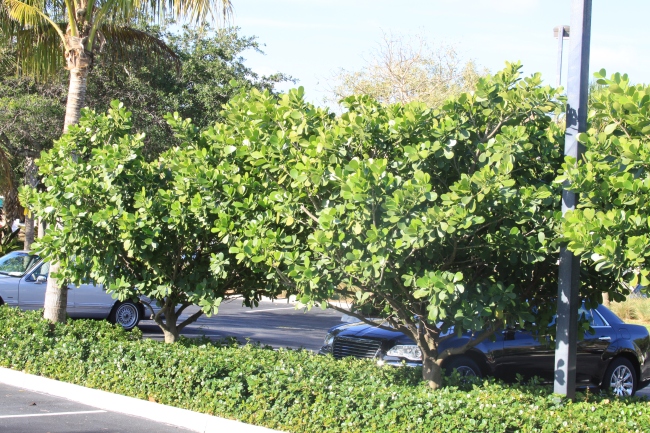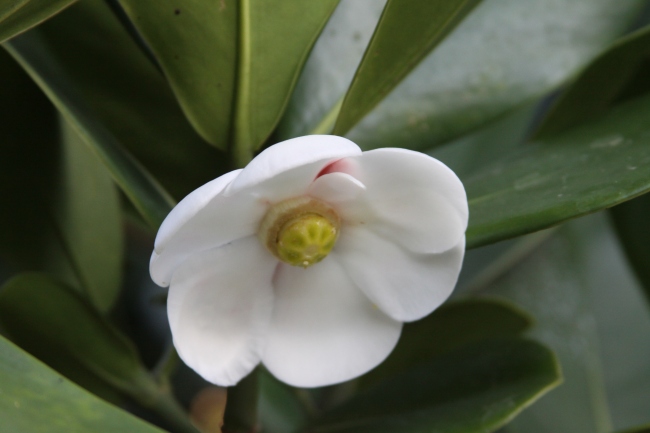Autograph Tree, Pitch-Apple, Rose-Apple
Clusia rosea
Clusiaceae
The Autograph Tree (Clusia rosea), also called Pitch-Apple or Rose-Apple, is presumably native from the Keys, more or less, to South America. It may seem a stretch at first glance, but this tree is kin to the yellow weeds known as St. Johnsworts, which are sold in health food stores as natural antidepressants, and which cause dermatological ailments in cows. First paragraph, and we’re off-topic already.
Back to Autograph Tree, and a little descriptive info to get us all on the same leaf. Today’s species can become a substantial tree, let’s say 35 feet tall with a hunky trunk. One in my yard went from a potted plant to about 20 feet tall in a decade. The foliage is full, thick, and utterly opaque, forming a dense screen against peekaboo, noisy neighbors, and wind. The canopy snags the wind maybe too much; a big branch at my house busted this summer in a thunderstorm. The paired leaves are thicker than leather, almost succulent, and the flowers are big and round, white and blushed variably with a rose.
The species is a player in landscaping. It is attractive as well as rugged and forgiving, easy to grow. Sunshine is best. It thrives despite drought (but prefers adequate water), harsh life, thin poor soils, alkaline dirt, and salty breezes. Bug and disease problems are few, except maybe for some scale insects. It is almost idiotproof. Good parking lot tree.
Still better for the landscaper, Autograph Tree sneers at damage and pruning, making it an option for large hedges, given its opacity and its tendency for low, multi-trunked growth. Alternatively, training can yield a conventional single-trunked tree.
Authors are fond of pointing out similarity to the Seven-Year Apple. Casasia clusiifolia, in the Coffee Family. There is no relationship, and Casasia differs by having thinner leaves with stipules.
The name “Autograph” Tree comes from the persistence of the leaves. You can scratch your initials and those of your sweetie onto them, and that Pepe Le Pew vandalism may linger longer than your beloved. The “pitch” in the name refers to the gooey sap with uses overlapping pine pitch, such as gunky boat caulking. The “apple” is the toxic fleshy fruit. It opens like a shady guy at the bus station selling watches from inside an overcoat, to display seeds with orange-red arils. Arils are appendages on seeds useful in dispersal, in this case by birds. The arils are rich in fats, to the point that some Clusia-relatives have edible arils served in the kitchen. (Forget it.)
Now that we’re past all the boring stuff, let’s look at what makes the tree interesting. They look just a little like Strangler Figs, and likewise can start life perched on another tree and then drop roots to the ground, eventually engulfing the helpful host tree. Autograph Trees can sometimes wind up with stilts looking much like a Strangler Fig from the distance.
The extent to which wild Autograph Trees persist in Florida is debatable, probably just some in the Keys. The wild(ish) individuals are reportedly all female, but no worries: Those female trees form mature fruits and seeds without benefit of male pollination. The offspring are clones of the mother, and there can be more than one embryo per seed. Here we have a species perfectly adapted to island-hopping. A single bird delivering a single seed can bring to an island multiple potential baby trees, each capable of reproducing more clones without benefit of males. Perhaps the entire Florida population is a sorority descended from a single dispersal event.
Those female flowers do develop token male stamens, but the stamens form no pollen. Instead, they ooze resin. Bees use the resin for caulking their nests, a rather unique floral reward.

